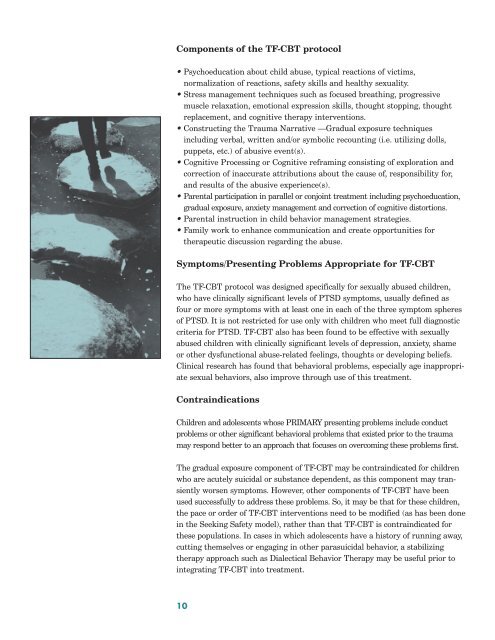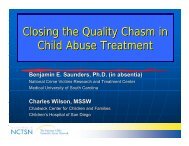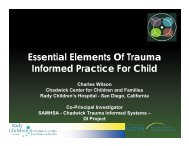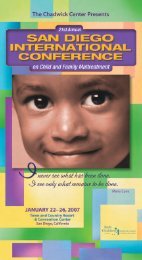Kauffman Best Practices Project Final Report - The Chadwick Center ...
Kauffman Best Practices Project Final Report - The Chadwick Center ...
Kauffman Best Practices Project Final Report - The Chadwick Center ...
Create successful ePaper yourself
Turn your PDF publications into a flip-book with our unique Google optimized e-Paper software.
Components of the TF-CBT protocol<br />
• Psychoeducation about child abuse, typical reactions of victims,<br />
normalization of reactions, safety skills and healthy sexuality.<br />
• Stress management techniques such as focused breathing, progressive<br />
muscle relaxation, emotional expression skills, thought stopping, thought<br />
replacement, and cognitive therapy interventions.<br />
• Constructing the Trauma Narrative —Gradual exposure techniques<br />
including verbal, written and/or symbolic recounting (i.e. utilizing dolls,<br />
puppets, etc.) of abusive event(s).<br />
• Cognitive Processing or Cognitive reframing consisting of exploration and<br />
correction of inaccurate attributions about the cause of, responsibility for,<br />
and results of the abusive experience(s).<br />
• Parental participation in parallel or conjoint treatment including psychoeducation,<br />
gradual exposure, anxiety management and correction of cognitive distortions.<br />
• Parental instruction in child behavior management strategies.<br />
• Family work to enhance communication and create opportunities for<br />
therapeutic discussion regarding the abuse.<br />
Symptoms/Presenting Problems Appropriate for TF-CBT<br />
<strong>The</strong> TF-CBT protocol was designed specifically for sexually abused children,<br />
who have clinically significant levels of PTSD symptoms, usually defined as<br />
four or more symptoms with at least one in each of the three symptom spheres<br />
of PTSD. It is not restricted for use only with children who meet full diagnostic<br />
criteria for PTSD. TF-CBT also has been found to be effective with sexually<br />
abused children with clinically significant levels of depression, anxiety, shame<br />
or other dysfunctional abuse-related feelings, thoughts or developing beliefs.<br />
Clinical research has found that behavioral problems, especially age inappropriate<br />
sexual behaviors, also improve through use of this treatment.<br />
Contraindications<br />
Children and adolescents whose PRIMARY presenting problems include conduct<br />
problems or other significant behavioral problems that existed prior to the trauma<br />
may respond better to an approach that focuses on overcoming these problems first.<br />
<strong>The</strong> gradual exposure component of TF-CBT may be contraindicated for children<br />
who are acutely suicidal or substance dependent, as this component may transiently<br />
worsen symptoms. However, other components of TF-CBT have been<br />
used successfully to address these problems. So, it may be that for these children,<br />
the pace or order of TF-CBT interventions need to be modified (as has been done<br />
in the Seeking Safety model), rather than that TF-CBT is contraindicated for<br />
these populations. In cases in which adolescents have a history of running away,<br />
cutting themselves or engaging in other parasuicidal behavior, a stabilizing<br />
therapy approach such as Dialectical Behavior <strong>The</strong>rapy may be useful prior to<br />
integrating TF-CBT into treatment.<br />
10






